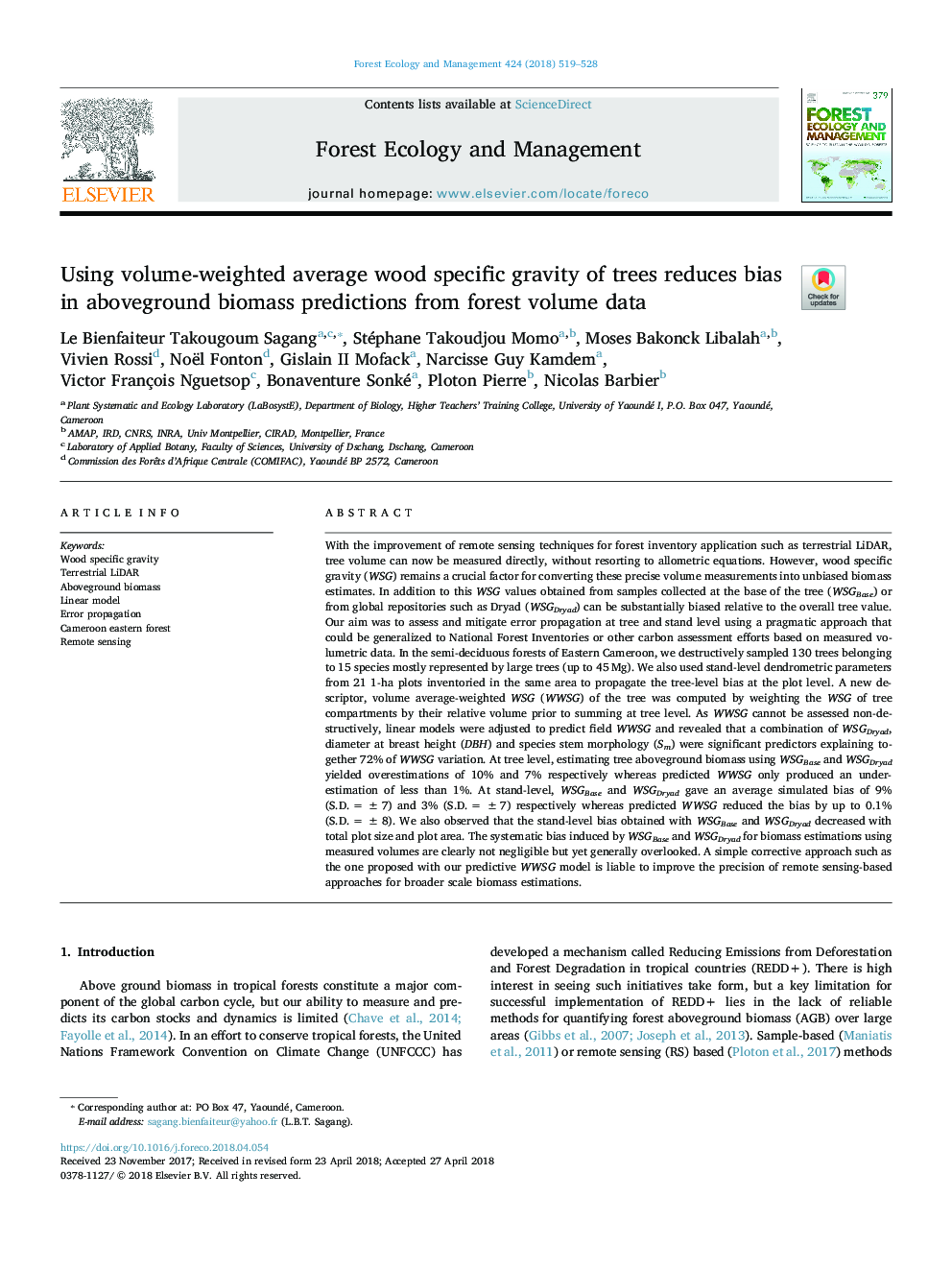| کد مقاله | کد نشریه | سال انتشار | مقاله انگلیسی | نسخه تمام متن |
|---|---|---|---|---|
| 6541623 | 1421336 | 2018 | 10 صفحه PDF | دانلود رایگان |
عنوان انگلیسی مقاله ISI
Using volume-weighted average wood specific gravity of trees reduces bias in aboveground biomass predictions from forest volume data
ترجمه فارسی عنوان
با استفاده از وزن متوسط تراکم درختان درختان، تعصب در پیش بینی های زیست توده زمین از داده های حجم جنگل استفاده می شود
دانلود مقاله + سفارش ترجمه
دانلود مقاله ISI انگلیسی
رایگان برای ایرانیان
کلمات کلیدی
موضوعات مرتبط
علوم زیستی و بیوفناوری
علوم کشاورزی و بیولوژیک
بوم شناسی، تکامل، رفتار و سامانه شناسی
چکیده انگلیسی
With the improvement of remote sensing techniques for forest inventory application such as terrestrial LiDAR, tree volume can now be measured directly, without resorting to allometric equations. However, wood specific gravity (WSG) remains a crucial factor for converting these precise volume measurements into unbiased biomass estimates. In addition to this WSG values obtained from samples collected at the base of the tree (WSGBase) or from global repositories such as Dryad (WSGDryad) can be substantially biased relative to the overall tree value. Our aim was to assess and mitigate error propagation at tree and stand level using a pragmatic approach that could be generalized to National Forest Inventories or other carbon assessment efforts based on measured volumetric data. In the semi-deciduous forests of Eastern Cameroon, we destructively sampled 130 trees belonging to 15 species mostly represented by large trees (up to 45â¯Mg). We also used stand-level dendrometric parameters from 21 1-ha plots inventoried in the same area to propagate the tree-level bias at the plot level. A new descriptor, volume average-weighted WSG (WWSG) of the tree was computed by weighting the WSG of tree compartments by their relative volume prior to summing at tree level. As WWSG cannot be assessed non-destructively, linear models were adjusted to predict field WWSG and revealed that a combination of WSGDryad, diameter at breast height (DBH) and species stem morphology (Sm) were significant predictors explaining together 72% of WWSG variation. At tree level, estimating tree aboveground biomass using WSGBase and WSGDryad yielded overestimations of 10% and 7% respectively whereas predicted WWSG only produced an underestimation of less than 1%. At stand-level, WSGBase and WSGDryad gave an average simulated bias of 9% (S.D.â¯=â¯Â±7) and 3% (S.D.â¯=â¯Â±7) respectively whereas predicted WWSG reduced the bias by up to 0.1% (S.D.â¯=â¯Â±8). We also observed that the stand-level bias obtained with WSGBase and WSGDryad decreased with total plot size and plot area. The systematic bias induced by WSGBase and WSGDryad for biomass estimations using measured volumes are clearly not negligible but yet generally overlooked. A simple corrective approach such as the one proposed with our predictive WWSG model is liable to improve the precision of remote sensing-based approaches for broader scale biomass estimations.
ناشر
Database: Elsevier - ScienceDirect (ساینس دایرکت)
Journal: Forest Ecology and Management - Volume 424, 15 September 2018, Pages 519-528
Journal: Forest Ecology and Management - Volume 424, 15 September 2018, Pages 519-528
نویسندگان
Le Bienfaiteur Takougoum Sagang, Stéphane Takoudjou Momo, Moses Bakonck Libalah, Vivien Rossi, Noël Fonton, Gislain II Mofack, Narcisse Guy Kamdem, Victor François Nguetsop, Bonaventure Sonké, Ploton Pierre, Nicolas Barbier,
